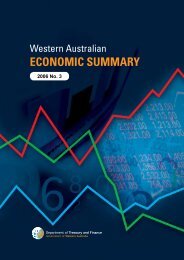Garnaut Fitzgerald Review of Commonwealth-State Funding
Garnaut Fitzgerald Review of Commonwealth-State Funding
Garnaut Fitzgerald Review of Commonwealth-State Funding
Create successful ePaper yourself
Turn your PDF publications into a flip-book with our unique Google optimized e-Paper software.
CHAPTER 2: How the System Grew:<br />
A History <strong>of</strong> <strong>Commonwealth</strong> Grants to the <strong>State</strong>s<br />
Western Australia was particularly disadvantaged by some effects <strong>of</strong> Federation, with<br />
the <strong>Commonwealth</strong> granting it a special exception to the application <strong>of</strong> the national tariff,<br />
to phase out by 1906. When the special tariff expired, Western Australia’s problems had<br />
not significantly eased, and it applied for and relied on the <strong>Commonwealth</strong>’s special<br />
grants for support well into the 1920s (Mathews and Jay 1997).<br />
The concept <strong>of</strong> equalising grants became a feature <strong>of</strong> the intergovernmental system<br />
more generally, mainly in recognition <strong>of</strong> Tasmania’s situation (Matthews and Jay 1997).<br />
After experiencing fiscal trouble both before and after the Federation, Tasmania first<br />
applied for special financial assistance in 1911. The <strong>State</strong> became increasingly vocal in<br />
expressing grievances regarding the fiscal impact <strong>of</strong> the Federal system. While Western<br />
Australia was most affected by the uniform national tariff, Tasmania and South Australia<br />
also felt the effects. All three <strong>State</strong>s expressed concern about the impact <strong>of</strong> the<br />
Navigation Act 1912, which artificially inflated the freight costs for manufactured goods,<br />
and the <strong>Commonwealth</strong> Conciliation and Arbitration Act 1904 (CGC 1995).<br />
Requests by Western Australia, South Australia and Tasmania for special assistance<br />
increased throughout the 1920s and early 1930s. These requests were subjected to, at<br />
best, haphazard assessment by a variety <strong>of</strong> bodies and institutions (Prest 1964).<br />
Several Royal Commissions examined the impact <strong>of</strong> Federation on <strong>State</strong>s. The first <strong>of</strong><br />
these was the 1925 Royal Commission on the Finances <strong>of</strong> Western Australia as<br />
Affected by Federation.<br />
Support for a new method <strong>of</strong> assisting the <strong>State</strong>s emerged from a 1925 Royal<br />
Commission on the problems <strong>of</strong> Tasmania, with Hobart statistician L.F. Giblin convincing<br />
the Royal Commission to suggest a shift away from the equal per capita distribution<br />
system.<br />
In 1926, Giblin advocated a system <strong>of</strong> differential per capita payments, arguing for the<br />
establishment <strong>of</strong> an independent institution to distance grant allocation from the political<br />
process (Prest 1964). He believed the per capita system <strong>of</strong> payment, in place since<br />
World War I, could be made to function more efficiently (CGC 1980). Further support<br />
was presented before the 1928 Royal Commission on the Constitution, most notably<br />
from Giblin, J.B. Brigden and L.G. Melville. In 1929 the Labor Party, which had refused<br />
representation on an independent institution in opposition, was elected. As the report’s<br />
recommendations faded into obscurity (CGC 1995), grant allocations continued to be<br />
dealt with at the political level.<br />
FINAL REPORT [23]

















